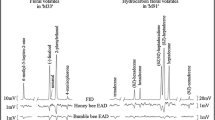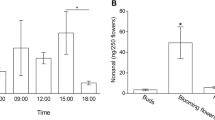Abstract
We present a review of work on the plant chemicals involved in the honeybee-sunflower model system. Combined behavioral and chemical analyses were conducted under natural and controlled conditions. First the distribution of forager bees' visits on two pairs of sunflower genotypes producing a different level of hybrid seed yield was recorded under pollen-proof tunnels. Mirasol parental lines producing high seed yields were visited at random, whereas forager bees visited preferentially the female parental line of Marianne, resulting in low seed yield. Nectar samples collected on the genotypes were analyzed by gas chromatography. Fructose, glucose, and sucrose were identified. Parental lines of Mirasol showed similar sugar profiles, whereas the female line of Marianne contained higher amounts of sucrose than the male line. We assume that the bees' preferences between genotypes might rely on differences in the sugar composition of floral nectars, especially in the amount of sucrose. Aromas from headspace collection were compared between pairs and periodically during the flowering period. Of the 144 components indexed for Marianne lines and 136 components for Mirasol lines, 17 of the components for Marianne lines and 18 for Mirasol lines differed significantly according to flowering stage. Significant differences appeared in eight of the 134 components of Marianne lines and in 20 of the 250 components for Mirasol lines. Such differences, even restricted to a few components, might account for honeybees' discrimination between genotypes or flowering stage. Experiments then were conducted in a flight room using an artificial flower device. A total volatile extract was used as a conditioning scent previous to the test where the total extract was successively compared to several of its subfractions. Fractions significantly less visited than the total extract were discarded, whereas fractions confused with the total extract were kept. From step to step, a restricted fraction of 28 polar components, among which 15 were identified, was shown to be as active as the initial conditioning extract. These data emphasized honeybees' abilities to generalize from simplified to more complex chemical information. Finally, this work considers the possible use of such plant chemicals, from nectars or aromas, either as targets for genetic modification of crop plants or as direct attractants when sprayed on the crop, for the improvement of entomophilous cross pollination.
Similar content being viewed by others
References
Baker, I., andBaker, H.G. 1976. Analyses of amino acids in flower nectars of hybrids and their parents, with phylogenetic implications.New Phytol. 76:87–98.
Black, L.T., andBagley, E.B. 1978. Determination of oligosaccharides in soybeans by high pressure liquid chromatography using an internal standard.J. Ann. Oil Chem. Soc. 55:228–232.
Burgett, M. 1980. The use of lemon balm (Melissa officinalis) for attracting honeybee swarms.Bee world 61 (2):45–46.
Buttery, R.G., Ling, L.C., andChan, B.G. 1978. Volatiles of corn kernels and husks: Possible corn ear worm attractants.J. Agric. Food Chem. 26:865–869.
Dawson, G.W., Hallahan, D.L., Mudd, A., Patel, M.M., Pickett, J.A., Wadhams, L.J., andWallsgrove, R.M. 1989. Secondary plant metabolites as targets for genetic modification of crop plants for pest resistance.Pestic. Sci. 27:191–201.
Delaude, A., Tasei, J.N., andRollier, M. 1979. Pollinator insects of sunflower (Helianthus annuus L.) in France, pp. 29–40, Proceedings, IVth International Symposium on Pollination. Md. Agric. Exp. Sta. Spec. Misc. Publ. College Park, Maryland.
Drane, D.,McPherson, R., andWhite, K. 1982. Pollination studies in hybrid sunflower seed production, pp. 25–99, Proceedings, Xth International Sunflower Conference, Australia.
Eckert, W.R., Zeman, A., andMoser, R. 1973. Occurrence of terpene hydrocarbons in sunflower oil.Fette, Scifen, Anstrichm. 75 (8): 475–478.
Erickson, E.H., Thorp, R.W., Briggs, B.D., Estes, J.R., Daun, R.J., Marks, M., andSchroeder, C.H. 1979. Characterization of floral nectars by high-performance liquid chromatography.J. Apic. Res. 18 (2): 148–152.
Etievant, P.X., andBayonove, C.L. 1983. Aroma components of pomaces and wine from the variety Muscat de Frontignan.J. Sci. Food Agric. 34:393–403.
Etievant, P.X., Azar, M., Pham-Delegue, M.H., andMasson, C. 1984. Isolation and identification of volatile constituents of sunflower (Helianthus annuus L.).J. Agric. Food Chem. 32 (3): 503–509.
Finch, S. 1977. Effect of secondary plant substances on host-plant selection by the cabbage root fly.Colloq. Int. CNRS, 265:251–267.
Fonta, C., Pham-Delegue, M.H., Marilleau, R., andMasson, C. 1985. Rôle des nectars de tournesol dans le comportement des insectes pollinisateurs et analyse qualitative et quantitative des éléments glucidiques de ces sécrétions.Acta Oecol. Oecol. Appl. 6 (2): 175–186.
Free, J.B., andSimpson, J. 1964. The pollination requirements of sunflowers.Emp. J. Exp. Agric. 32 (128):340–342.
Freund, D.E., andFurgala, B. 1982. Effect of pollination by insects on the seed set and yield of ten oilseed sunflower cultivars.Am. Bee J. 122:648–652.
Frisch, K. von 1967. The Dance Language and Orientation of Bees. The Belknap Press of Harvard University Press, Cambridge, Massachusetts. 566 pp.
Gascuel, J., andMasson, C. 1987. Influence of olfactory deprivation on synapse frequency in developing antennal lobe of the honeybee.Apis mellifera. Neurosci. Res. Commun. 1 (3):173–180.
Gershenzon, J., Ohno, N., andMabry, T.J. 1981. The terpenoid chemistry of sunflowers (Helianthus).Rev. Latinoam. Quim. 12 (2):53–61.
Guérin, P.M., Städler, E., andBuser, H.R. 1983. Identification of host-plant attractants for the carrot flyPsila rosae.J. Chem. Ecol. 9 (7): 843–861.
Gühler, B. 1930. Meine Erfahrungen mit Melissenkraut.Bienenvater 62:179–182.
Hedin, P.A. 1976. Seasonal variations in the emission of volatiles by cotton plants growing in the field.Environ. Entomol. 5:1234–1238.
Koch, K. 1931. Die gebraüchliche oder Zitronenmelisse.Märkirsche Bienen-ztg. 21:106–108.
Koltermann, R. 1973. Rassen-bzw. artspezifische Duftbevertung bei der Honigbiene und ökologische Adaptation.J. Comp. Physiol. 85:327–360.
Leclercq, P. 1969. Une stérilité mâle cytoplasmique chez le tournesol.Ann. Amelior. Plant. 19 (2):99–106.
Masson, C. 1982. Physiologie sensorielle et comportement de l'abeille.C.R. Acad. Agric. 68:1350 -1361.
Masson, C., andArnold, G. 1984. Ontogeny, maturation and plasticity of the olfactory system of the worker bee.J. Insect Physiol. 30 (1):7–14.
Menzel, R. 1967. Untersuchungen zum Erlernen von Spektralfarben durch die Honigbiene (Apis mellifica).Z. Vergl. Physiol. 56:22–62.
Mesquida, J.,Renard, M.,Pellan-Delourme, R.,Pelletier, G., andMorice, J. 1988. Influence des sécrétions nectarifères des lignées mâles-stériles pour la production de semences hybrides F1 de colza, pp 269–280,in Variabilité génétique cytoplasmique et stérilité mâle cytoplasmique, Les Colloques de l'INRA, INRA (ed.), Sainte-Sabine, France, 45.
Parker, F.D. 1981. Sunflower pollination: Abundance diversity and seasonality of bees and their effect on seed yields.J. Apic. Res. 20(1):49–61.
Pham-Delegue, M.H., andMasson, C. 1985. Analyse par conditionnement associatif du mécanisme de la reconnaissance de sources alimentaires par l'abeille.Bull. Soc. Entomol. Fr. 90:1216–1223.
Pham-Delegue, M.H., Masson, C., Etievant, P., andAzar, M. 1986. Selective olfactory choices of the honeybee among sunflower aromas: A study by combined olfactory conditioning and chemical analysis.J. Chem. Ecol. 12:781–793.
Pham-Delegue, M.H., Etievant, P., andMasson, C. 1987. Molecular parameters involved in bee-plant relationships: A biological and chemical approach.Biochimie 69:661–670.
Pham-Delegue, M.H., Etievant, P., Guichard, E., andMasson, C. 1989. Sunflower volatiles involved in honeybee discrimination among genotypes and flowering stages.J. Chem. Ecol. 15:329–343.
Pham-Delegue, M.H., Roger, B., Charles, R., andMasson, C. 1990. Effet d'une pré-exposition olfactive sur un comportement d'orientation en olfactomètre dynamique à quatre voies chez l'abeille (Apis mellifica L.).Insect Soc. 37:181–187.
Popescu, H. 1982. Les fleurs deHelianthus annuus L., possible source d'essence à menthol.Clujul. Med. 55 (3):199–203.
Putt, E.D. 1978. History and present world status, pp. 1–29,in J.F. Carter (ed.). Sunflower Science and Technology. American society of Agronomy, Madison, Wisconsin.
Radford, B.J., andRhodes, J.W. 1978. Effect of honeybee activity on the cross pollination of male sterile sunflower.Queensl. J. Agric. Sci. 35:153–157.
Severson, D.W., andErickson, E.H. 1983. High performance liquid-chromatography of carbohydrates in cucumber nectar.J. Apic. Res. 22 (3): 158–162.
Tepedino, V.J., andParker, F.D. 1982. Interspecific differences in the relative importance of pollen and nectar to bee species foraging on sunflowers.Environ. Entomol. 11:246–250.
Thiery, D., Bluet, J.M., Pham-Delegue, M.H., Etievant, P., andMasson, C. 1990. Sunflower aroma detection by the honeybee. Study by coupling gas chromatography and electroantennography.J. Chem. Ecol. 16:701–711.
Vear, F., Pham-Delegue, M.H., Tourvieille deLabrouhe, Marilleau, R., Loublier, Y., Le Metayer, M., Douault, Ph., andPhilippon, J.P. 1990. Genetical studies of nectar and pollen production in sunflower.Agronomie 10:219 -231.
Visser, J.H., Van Straten, S., andMaarse, H., 1979. Isolation and identification of volatiles in the foliage of potatoSolanium tuberosum, a host plant of the Colorado beetleLeptinotarsa decemlineata.J. Chem. Ecol. 5:13–25.
Waller, G.D., Carpenter, E.W., andZiehl, O.A. 1972. Potassium in onion nectar and its probable effect on attractiveness of onion flowers to honey bees.J. Am. Soc. Hortic. Sci. 97 (4):535–539.
Wenner, A.M., Wells, P.H., andJohnson, D.L. 1969. Honeybee recruitments to food sources: Olfaction or language?Science 164:84–86.
Williams, I.H., Pickett, J.A., andMartin, A.P. 1981a. The Nasanov pheromone of the honeybeeApis mellifera L. (Hymenoptera, Apidae). Part II. Bioassay of the components using foragers.J. Chem. Ecol. 7:225–237.
Williams, I.H., Pickett, J.A., andMartin, A.P. 1981b. Attraction of honeybees to flowering plants by using synthetic Nasanov pheromone.Entomol. Exp. Appl. 30:199–201.
Author information
Authors and Affiliations
Rights and permissions
About this article
Cite this article
Pham-Delegue, M.H., Etievant, P., Guichard, E. et al. Chemicals involved in honeybee-sunflower relationship. J Chem Ecol 16, 3053–3065 (1990). https://doi.org/10.1007/BF00979612
Received:
Accepted:
Issue Date:
DOI: https://doi.org/10.1007/BF00979612




